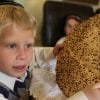When Moses instructed the Jews to prepare matzah for the Passover Eve feast (scheduled for the night before their anticipated departure from Egypt), he enjoined them to "guard the matzahs" (Exodus 12:17). This verse is the basis of an interesting law. It is not enough to eat matzah on the Seder night; it is also a mitzvah to guard the matzah's dough as it is being prepared for baking, so that it does not rise.
Jewish law rules that there are two very different kinds of matzah.
One is the matzah that we eat throughout most of Passover. That matzah is considered "optional." We don't have to eat matzah; we could eat other foods that are not chametz (leavened) such as dairy, fish, meat, fruits and vegetables. As long as we do not eat chametz, we are in keeping with the rules of the holiday. If however we choose to eat bread, it would have to be of the matzah variety.
It isn't only the result that counts; it is also the effort we put into itThe situation is very different during the first two Seder nights of Passover. On those two nights it is mandatory to eat matzah, so that we recall the unleavened bread eaten by our ancestors as they left Egypt. The matzah of the Seder is called matzot mitzvah ("obligatory matzah") and there are special rules dictating how it should be baked.
An example of this concept would be the rules of a kosher mezuzah. The mitzvah of mezuzah begins even before we attach it to our doorpost; it starts with the way the mezuzah is written, with a skilled scribe (called a sofer) writing the words of the Shema on parchment. The scribe must be a Jewish adult, who himself is obligated in the mitzvah of mezuzah. A computer generated printout might be neat and precise, but it would not constitute a kosher mezuzah, because it is incapable of doing a "Jewish" mitzvah.
In very much the same way, the baking of the Seder matzah is the beginning of the mitzvah. Mixing the dough, rolling and shaping the matzah and putting the dough into the oven to bake—are all activities that must be performed by adult Jews. This is why machine-made matzah is not the best choice for the Seder. Hand-baked matzah is becoming more and more popular and many people eat them for the entire Passover. Certainly, the hand-baked matzah are the optimum choice for the Seder nights.
It is easy to recognize a hand-baked matzah, because they are round in contrast to the square-shaped machine-made variety. Interestingly, the Torah describes the matzah that the Jews ate when they left Egypt as "ugot," a Hebrew word that also means round-shaped.
There is an important lesson that we can learn from matzah. It isn't only the result that counts; it is also the effort we put into it. In today's world of automation, we sometimes forget the beauty and value of personal involvement. A mitzvah requires human effort (and there are few mitzvot that demand as much effort as the preparations for Passover...).
A machine can produce matzah that is neat and tasty, but it is human effort and hard work that makes the matzah a true mitzvah. Only hard effort can yield true value.







Join the Discussion